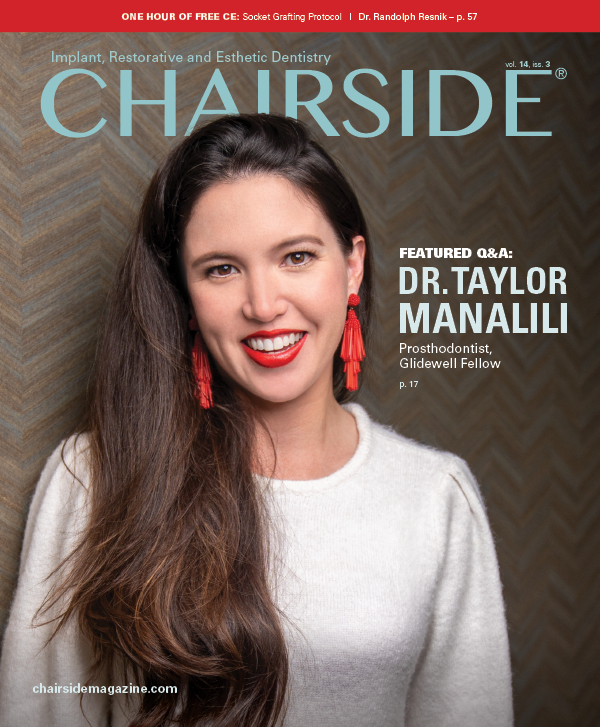A glidewell.io™ Practice Report: Impressing Even the Most Tech-Savvy of Doctors
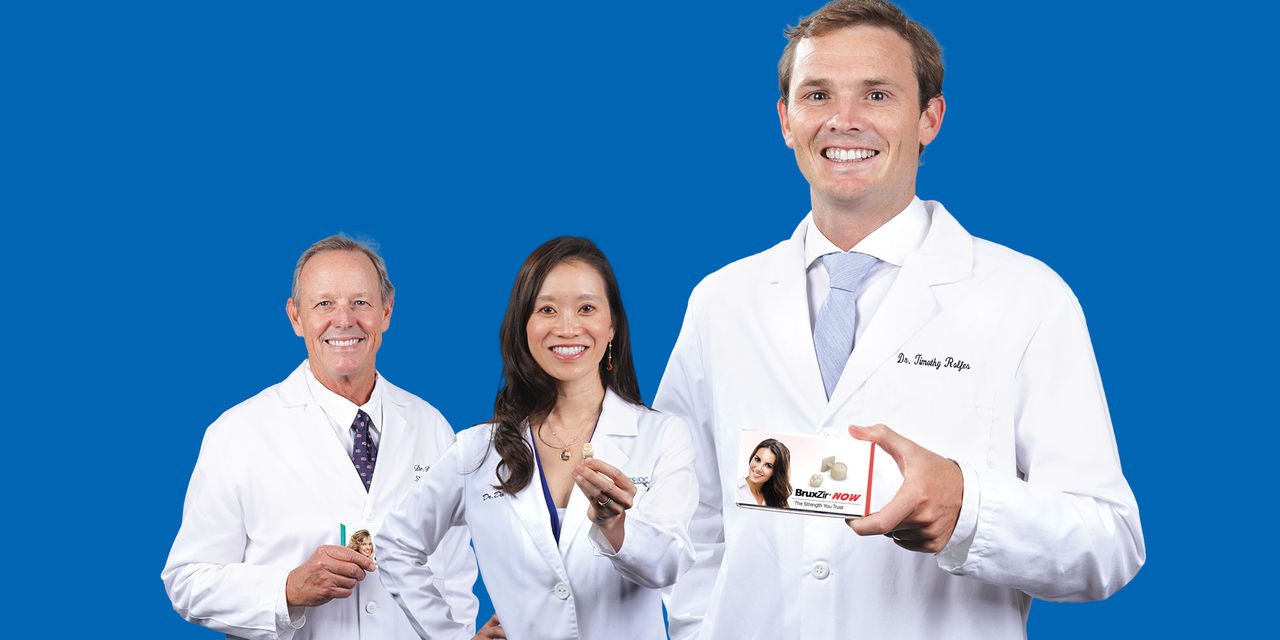
Dr. Thomas Rolfes of Smiles4OC in Costa Mesa, California, is among those doctors who embrace all the latest developments in dental technology. In fact, Dr. Rolfes and his team have a reputation in their community for being the first to implement a variety of new technologies to enhance clinical outcomes and patient comfort. That’s why we were eager to sit down with Dr. Rolfes and hear his thoughts about the glidewell.io™ In-Office Solution, a single-visit dentistry system designed for plug-and-play operation that’s accessible to all dental practitioners, regardless of their digital know-how.
CHAIRSIDE® MAGAZINE: Dr. Rolfes, please tell us a bit about your education and background in dentistry.
DR. THOMAS ROLFES: It’s been a pretty linear progression for me. I graduated from dental school in 1984, and my first position post-graduation was actually right here at Smiles4OC. Years ago, when this practice first opened, my mother was the first hygienist they ever hired. So it felt natural for me to join the team. In those days, we had just one senior doctor, who retired in 1986. At that point, I took over the practice.
CM: So you’ve been here at Smiles4OC for your whole dental career. I’m sure you’ve seen the practice evolve quite a bit over time.
TR: Yes, we’ve grown exponentially since the year I took over. We’ve added a few specialists to the staff, and we’ve also grown from one doctor to four. About two years ago my son Tim joined the staff as our most recent doctor, so that’s been exciting and a lot of fun.
CM: What types of procedures does your practice typically handle? Any particular areas of focus?
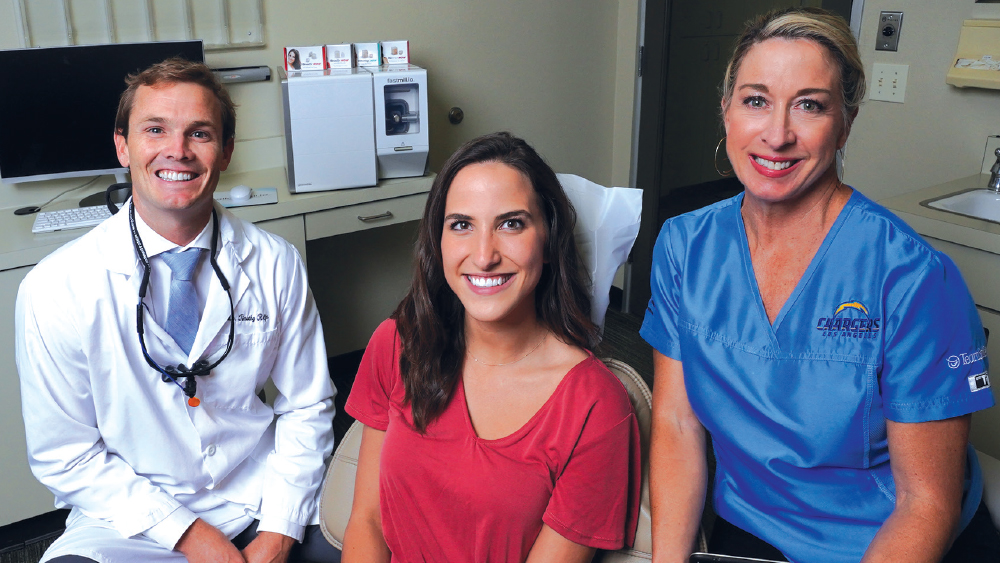
The fourth doctor to join the growing staff of Smiles4OC was Dr. Timothy Rolfes, the son of Dr. Thomas Rolfes. Here, Timothy (left) is shown with a happy patient (center) and a member of the Smiles4OC team (right).
TR: We do pretty much everything. Our specialists, who rotate through on a regular schedule, include a maxillofacial surgeon and a periodontist. I have an anesthesia license along with my dental license, so I do a lot of IV sedation, which means we take on quite a few major cases that tend to require that. We also place and restore a lot of dental implants. We just do a lot of dentistry. In fact, we’re the team dentist for the Los Angeles Chargers, which is super fun and keeps us very busy, too, of course.
CM: That sounds like an interesting gig! What services does a team dentist handle? Do you fabricate the players’ mouthguards and things like that?
TR: We do handle their preventive devices, absolutely. We’re an official part of the team’s medical staff, so we’re on-site during their games, ready to help. We also treat the players and a number of people from the organization off the field, providing their regular dental care. The Chargers definitely appreciate the fact that we have the doctors, staff and proper equipment to handle all of their dental needs successfully.
CM: Speaking of equipment, I understand that the Smiles4OC team is known for being first out of the gate when it comes to trying out and implementing new technology as it comes to market.
TR: Yes, that’s true. We’ve always embraced technology and been pretty cutting-edge. Right now, for example, we have numerous lasers we use, including several BIOLASE Waterlase® units (BIOLASE Technology; Irvine, Calif.), plus some diode lasers we use in our hygiene program, and a few other types. If it’s good technology, we are very interested in it.
CM: I’m going to guess, then, that learning and implementing the glidewell.io In-Office Solution wasn’t too much of a stretch for you or the staff.
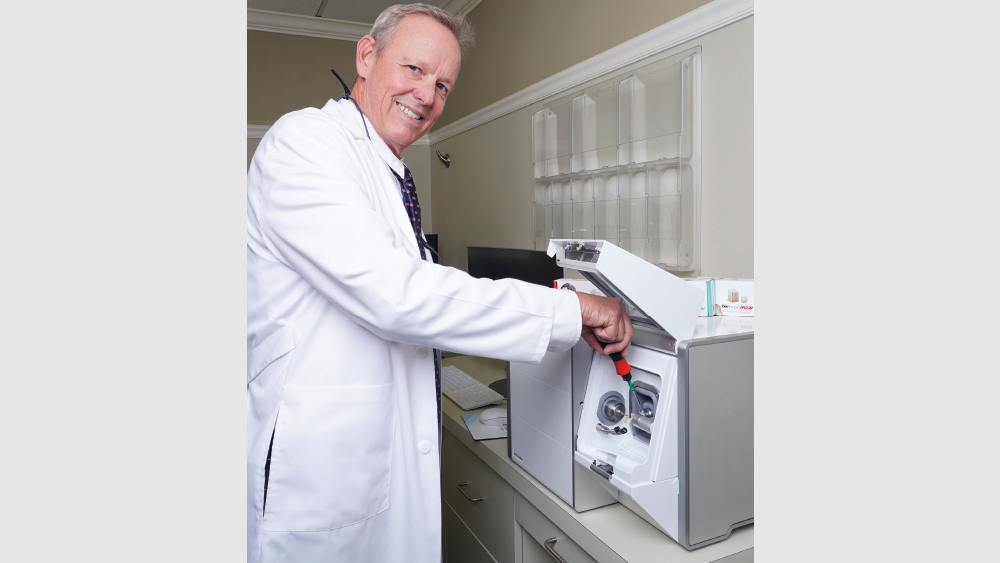
Dr. Thomas Rolfes, shown here in his practice with the fastmill.io™, is well-known for keeping his practice on the cutting edge when it comes to the latest in dental technology.
TR: That’s definitely true. I was on the design team for an intraoral scanner seven or eight years ago. The technology in those days wasn’t that great, so the scanner I worked with then was nowhere near as good as the iTero Element®, especially when the iTero is paired with the glidewell.io workflow.
CM: Considering that context, we’d love to hear your thoughts about glidewell.io.
TR: Let me put it to you this way — 10 years ago, I didn’t do a ton of business with Glidewell. I had used the same lab for years, and I didn’t have any reason to switch. Once in a while I’d need something I could source only from Glidewell, but otherwise, we barely crossed paths. However, I’m crisscrossing routes with Glidewell quite a lot these days. And it’s all due to glidewell.io, particularly the digital workflow the system creates. It’s completely flexible and incredibly easy to implement. The process that it creates in the practice is absolutely fabulous. Honestly, the workflow of glidewell.io has changed the way we practice dentistry completely. If we decide not to use the fastmill.io In-Office Mill for cases that are larger or that require more complex esthetic work, then we just send the scans to the Glidewell digital team through the software interface, and they fabricate excellent restorations for us in the lab.
CM: Coming from a doctor who knows technology so well, your approval is a huge compliment for glidewell.io.
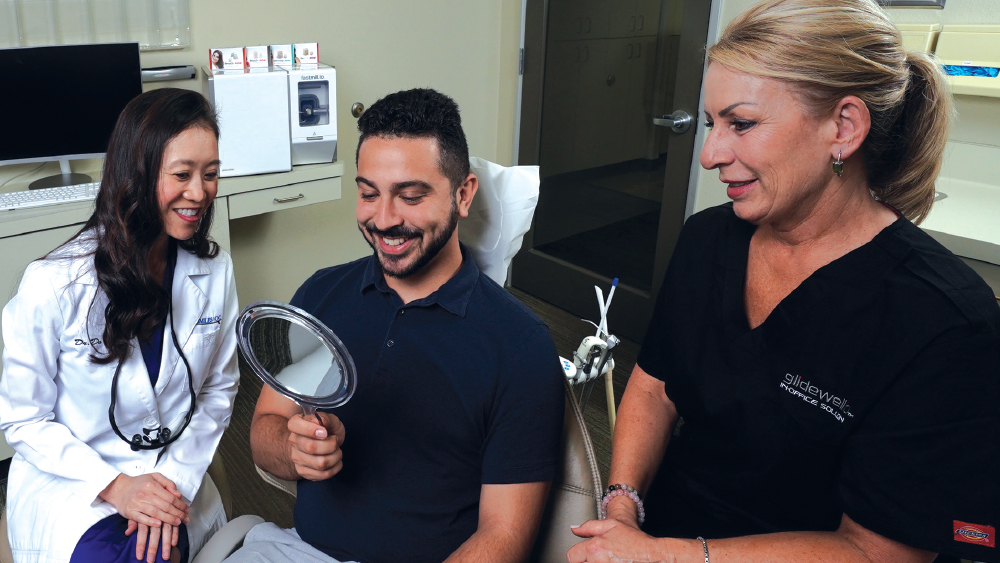
The flexible digital workflow of the glidewell.io In-Office Solution has allowed Dr. Rolfes and his team to provide the ultimate in convenient treatment to their patients.
TR: The system is great. It’s wonderful to know that when we’ve got a single-unit case on our hands, we can mill the restoration in-office in one appointment. We can even mill it with BruxZir® NOW milling blocks if we want to. Or, if the restoration requires it at any point in the process, we can just click and send the case along to Glidewell.
As I said, we use the laboratory at Glidewell constantly these days. At this point I wouldn’t go back to my previous lab anyway, even if their prices were lower than Glidewell’s — which they’re not. Crowns that are produced through glidewell.io are faster and cheaper — but more importantly, they’re better. Whichever workflow we use, the resulting restorations fit and look great.
CM: In terms of the workflow within the office, does your staff get involved with designing or milling?
TR: Absolutely — our team members pretty much handle the whole thing at this point. The doctor working on the case will often go into fastdesign.io™ and mark the margins just to make sure that we’ve placed them exactly where we want them. But then we just turn the case over to the staff, who can always reach out to the Glidewell support team for help with a design if they need it. The individuals on that support team, by the way, are easy to access and have provided a lot of assistance to our whole team. A member of our staff just makes a quick phone call, and the Glidewell tech can jump right into our system. The tech can adjust a couple of things in our design if they need to, and then we can load up a block and start milling just a few minutes later.
CM: What would you say have been the biggest, most influential benefits to your patients since you adopted glidewell.io?
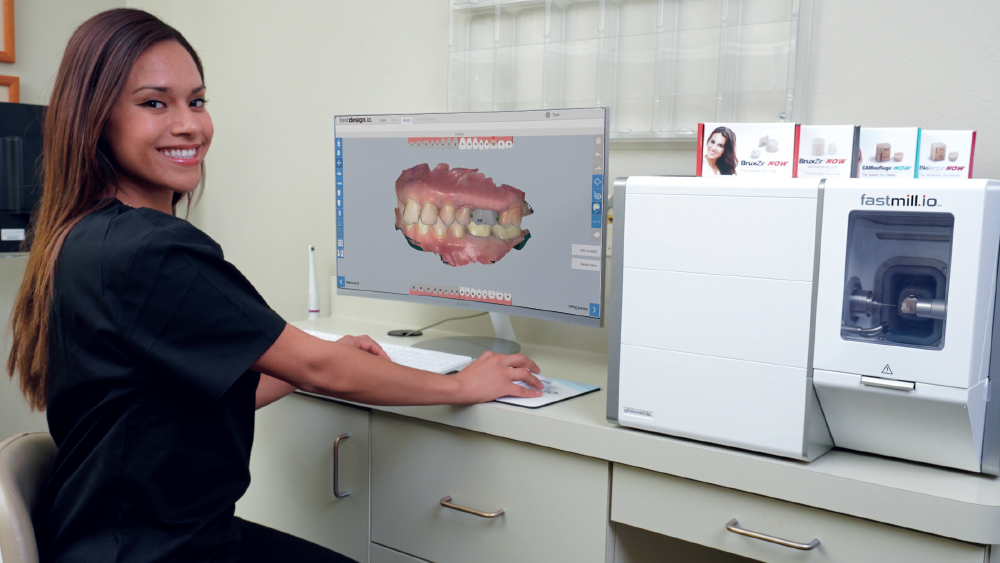
The whole team at Smiles4OC is trained in how to use the glidewell.io system to simplify and expedite the treatment process. If staff members have questions, they can instantly connect to Glidewell for one-on-one assistance.
TR: All of the benefits really stem from that one huge selling point: convenience. Let’s say, for example, that a patient needs a lower molar replaced. We mill almost all of our lower molar restorations in-office these days, and patients are very grateful that we can provide these restorations in the same appointment. That’s largely because the anesthesia required to work on those lower molars is difficult and uncomfortable. So the patients love it when we only have to administer anesthesia to them once! They walk out with a finished product, they don’t have to worry about breaking or losing a provisional, and they don’t have to come back in a week or two and get more injections in the same spot where their mouth is probably still sore. We bypass all of that. It’s wonderful for everyone involved.
CM: Are any patients ever tentative about the fact that your practice offers same-visit services? Is there any preconception among the patients that a lab-made crown might be better than one made in your clinic?
TR: Never. And I can see how someone might think the patients could have that kind of reaction. But honestly, our practice has a pretty sterling reputation in the community for having great technology and using it to deliver great care. So our patients are very trusting, which is fantastic. Their thought process is usually such that, if we’re using something new to treat them, it’s probably because that new thing is really good technology. I’ve had people ask about the differences between in-office crowns and the traditional lab ones. But they’re always very excited about doing it the new way instead.
CM: Are there any particular factors that you and your team look for when you’re considering bringing a type of new technology on board?
TR: Definitely. First of all, I’ll say that we’re very thankful that our practice is large enough to allow for the experimentation. We can afford to try out the new tech and procedures that interest us. We’ve also gotten really good at implementing new techniques into our day, which helps us avoid spending time going through a long learning curve before we can put the tools to use. We also do a lot of research on what we’re buying, of course, before we decide.
Just in general, though, we try to make good decisions about what we purchase, and we base those decisions on whether the investment will help us get the best results possible for our patients. If it’s going to result in faster or less expensive treatment, or just provide better results in any kind of way, we’re interested. That’s what gets us thinking about whether something is a good investment.
CM: That sounds like excellent and reasonable criteria for steering your way through as the industry continues to change so quickly.
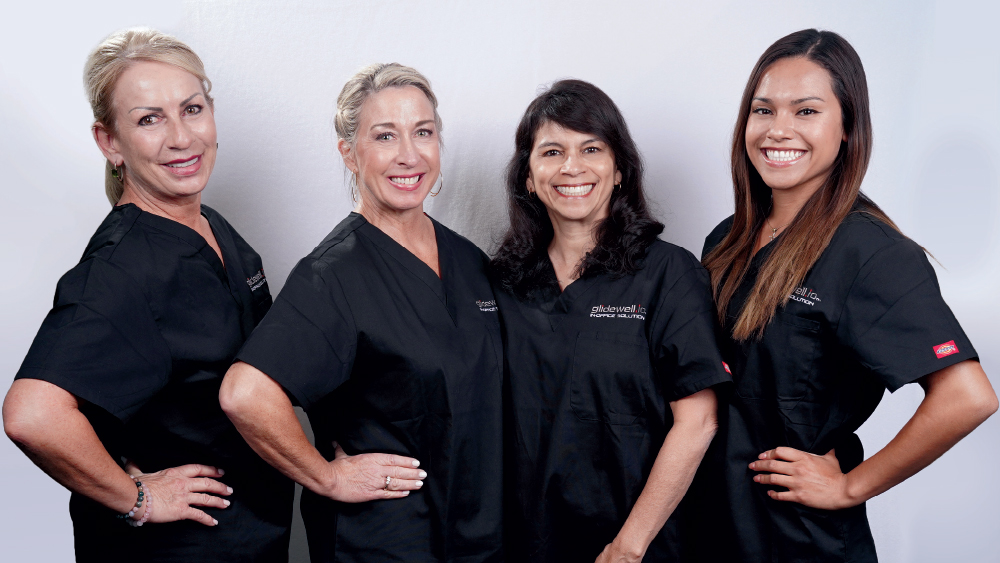
Smiles4OC is known in its community for being the first to try out new dental technology. The doctors and staff alike are proud of their ambitious reputation and love learning how to use the latest tools to improve patient care.
TR: Absolutely. And once we reach the point of interest, we run the numbers on long-term affordability and usefulness. In terms of those criteria, glidewell.io has been more than affordable — it’s cut our costs and increased our profit because we’re treating patients so quickly. It’s also been incredibly useful — the digital workflow it creates has been a game changer for our practice. Our glidewell.io system paid for itself in less than a year. And that’s the type of investment we’re happy to make.
CM: Dr. Rolfes, thank you so much for sharing your insights.
TR: It’s been my pleasure.

